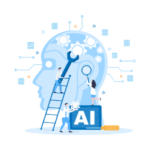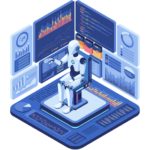What does an ML developer do? Create innovative solutions by leveraging data, algorithms, and computational power in harmony.

Machine learning (ML) has been a game-changer in technology, with ML developers at the forefront of this revolution. This expository essay will delve into the world of ML development, discussing the roles and responsibilities of an ML developer, the differences between ML and AI developers, and how to become an ML developer.
Key Roles and Responsibilities
An ML developer is responsible for designing, developing, and deploying machine learning models to solve complex problems. Some of their key tasks include:
- Data collection and preprocessing: ML developers gather and preprocess data, ensuring it’s clean and properly formatted for machine learning algorithms.
- Feature engineering: They identify and extract relevant features from the data to improve model performance.
- Model training and evaluation: ML developers train models using various algorithms, fine-tune hyperparameters, and evaluate their performance.
- Deployment and maintenance: They deploy ML models into production and monitor their performance, making necessary adjustments as needed.
Key Takeaway
ML developers play a crucial role in turning raw data into actionable insights using machine learning algorithms.
Exemplify
Imagine a company wanting to predict customer churn. An ML developer would collect historical data, preprocess it, engineer features, train and evaluate a model, and deploy it to make predictions on new data.
Pro Tip
Focus on mastering popular ML frameworks like TensorFlow or PyTorch, as they are widely used in the industry.
Pros and Cons
- Pros: High demand, lucrative salaries, and the opportunity to work on cutting-edge technologies.
- Cons: Can be stressful due to tight deadlines, evolving technologies, and the need for continuous learning.
ML Developer vs AI Developer
While the terms ML developer and AI developer are often used interchangeably, they refer to distinct roles within the broader field of artificial intelligence.
- ML developer: Primarily focuses on creating and deploying machine learning models to analyze and learn from data.
- AI developer: Works on a broader range of tasks, including natural language processing, computer vision, robotics, and more.
Key Takeaway
ML developers specialize in machine learning, while AI developers have a broader scope, encompassing various AI technologies.
Exemplify
An ML developer might work on a recommendation system for a streaming platform, while an AI developer could be creating a virtual assistant for voice-activated devices.
Pro Tip
To be successful as an AI developer, gain a solid understanding of ML and other AI technologies, such as deep learning, reinforcement learning, and knowledge representation.
Stats from 2021
- Average ML developer salary in the USA: $112,000 (source: Glassdoor)
- Average AI developer salary in the USA: $110,000 (source: Glassdoor)
Machine Learning Engineer Requirements
To become a successful ML engineer, one must possess a strong background in mathematics and statistics, proficiency in programming languages, expertise in ML algorithms and frameworks, and experience with big data tools like Hadoop and Spark.
How to Become an ML Developer
To become an ML developer, follow these steps:
- Gain a strong foundation in mathematics and statistics: ML relies on concepts from linear algebra, calculus, probability, and statistics.
- Learn programming languages: Python and R are popular languages in ML development.
- Master ML algorithms: Understand and implement various ML algorithms, such as regression, classification, clustering, and more.
- Develop expertise in ML frameworks: Become proficient in TensorFlow, PyTorch, or other ML frameworks.
- Build a portfolio: Showcase your skills through personal projects, internships, or contributing to open-source projects.
Key Takeaway
To become an ML developer, focus on building a strong foundation in math, programming, ML algorithms, and frameworks, and showcase your skills through a solid portfolio.
Exemplify
Create a project that predicts
housing prices using a linear regression model. This showcases your understanding of data preprocessing, feature engineering, and model evaluation.
Pro Tip
Participate in ML competitions like those on Kaggle to hone your skills and network with other professionals in the field.
ML Developer Jobs and Salaries
With the increasing demand for machine learning expertise, ML developer jobs have become highly sought after. Companies across various industries, such as healthcare, finance, and technology, require skilled ML developers to enhance their products and services.
Key Takeaway
ML developer jobs are in high demand, offering lucrative salaries and diverse opportunities across industries.
Exemplify
An ML developer might work for a healthcare company to develop algorithms for early disease detection or for a financial institution to detect fraudulent transactions.
Pro Tip
Keep an eye on job boards and networking sites like LinkedIn to stay updated on the latest ML developer job openings.
ML Developer Salary in the USA
As of 2021, the average ML developer salary in the USA is $112,000, with senior ML developers earning even higher salaries.
ML Engineer vs Data Scientist
While there is some overlap between the roles of an ML engineer and a data scientist, they have distinct responsibilities and skill sets.
- ML engineer: Primarily focuses on designing, building, and deploying machine learning models, as well as optimizing their performance.
- Data scientist: Works on a broader range of tasks, including data analysis, visualization, and hypothesis testing, in addition to building and deploying ML models.
Key Takeaway
ML engineers are more focused on the development and deployment of ML models, while data scientists work on a broader range of data-related tasks.
Exemplify
An ML engineer might be responsible for implementing a neural network to analyze image data, while a data scientist could be analyzing customer behavior patterns to inform marketing strategies.
Transfer Learning and Fine-Tuning
Transfer learning is a technique where an ML model, pre-trained on a large dataset, is adapted to solve a related problem. Fine-tuning involves adjusting the model’s parameters to optimize its performance for the new task.
Key Takeaway
Transfer learning and fine-tuning can significantly reduce training time and improve model performance by leveraging existing knowledge.
Exemplify
An ML developer might use a pre-trained image recognition model like ResNet50 and fine-tune it for a specific object detection task.
Pro Tip
Choose a suitable pre-trained model based on your task’s domain and requirements to maximize the benefits of transfer learning.
Reinforcement Learning
Reinforcement learning is an ML paradigm that enables agents to learn by interacting with their environment and receiving feedback in the form of rewards or penalties.
Key Takeaway
Reinforcement learning is a powerful technique for solving problems that require sequential decision-making and adaptive behavior.
Exemplify
An ML developer might use reinforcement learning to create a self-learning robot that can navigate complex environments.
Pro Tip
Familiarize yourself with popular reinforcement learning algorithms like Q-learning, SARSA, and Deep Q-Networks (DQNs).
Ethics and Responsible AI Development
With the increasing impact of AI on society, it is vital for ML developers to consider the ethical implications of their work and ensure responsible AI development.
Fairness, Accountability, and Transparency (FAT)
Fairness, Accountability, and Transparency (FAT) are essential principles for developing ethical AI systems that minimize bias, discrimination, and unintended consequences.
Key Takeaway
Incorporate FAT principles in your ML development process to create AI systems that are fair, accountable, and transparent.
Exemplify
An ML developer might use techniques like adversarial training or re-sampling to mitigate biases in a model used for hiring decisions.
Pro Tip
Stay updated on the latest research and tools related to AI ethics, such as fairness-aware ML algorithms and explainable AI techniques.
Continuous Learning and Adaptation
In the rapidly evolving field of AI, continuous learning and adaptation are critical for staying at the forefront of technology.
Lifelong Learning and Online Learning
Lifelong learning refers to ML models’ ability to continuously learn and adapt to new data, while online learning involves updating models incrementally with new data points.
Key Takeaway
Embrace continuous learning and adaptation to ensure your ML models remain relevant and effective in the face of changing data and requirements.
Exemplify
An ML developer might implement an online learning algorithm to update a fraud detection model with new transactions as they occur.
Pro Tip
Explore state-of-the-art lifelong learning techniques, such as memory-augmented neural networks and meta-learning, to keep your ML models up-to-date.
Conclusion
An ML developer plays a crucial role in harnessing the power of machine learning to solve complex problems across various industries. With high demand, lucrative salaries, and diverse opportunities, ML development is an exciting and rewarding career choice.
By building a strong foundation in mathematics, programming, ML algorithms, and frameworks, and showcasing your skills through a solid portfolio, you can embark on a successful career as an ML developer.
Jane Watson is a seasoned expert in AI development and a prominent author for the “Hire AI Developer” blog. With over a decade of experience in the field, Jane has established herself as a leading authority in AI app and website development, as well as AI backend integrations. Her expertise extends to managing dedicated development teams, including AI developers, Machine Learning (ML) specialists, and other supporting roles such as QA and product managers. Jane’s primary focus is on providing professional and experienced English-speaking AI developers to companies in the USA, Canada, and the UK.
Jane’s journey with AI began during her time at Duke University, where she pursued her studies in computer science. Her passion for AI grew exponentially as she delved into the intricacies of the subject. Over the years, she honed her skills and gained invaluable experience working with renowned companies such as Activision and the NSA. These experiences allowed her to master the art of integrating existing systems with AI APIs, solidifying her reputation as a versatile and resourceful AI professional.
Currently residing in the vibrant city of Los Angeles, Jane finds solace in her role as an author and developer. Outside of her professional pursuits, she cherishes the time spent with her two daughters, exploring the beautiful hills surrounding the city. Jane’s dedication to the advancement of AI technology, combined with her wealth of knowledge and experience, makes her an invaluable asset to the “Hire AI Developer” team and a trusted resource for readers seeking insights into the world of AI.







